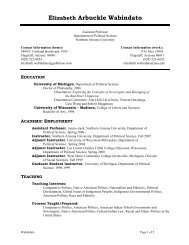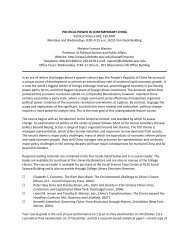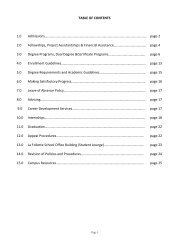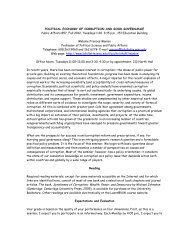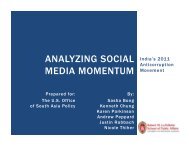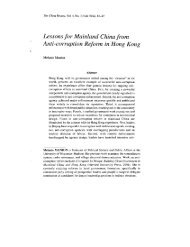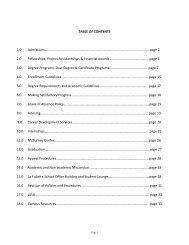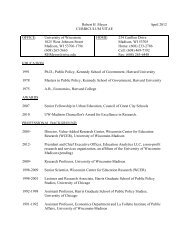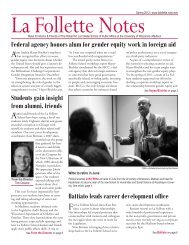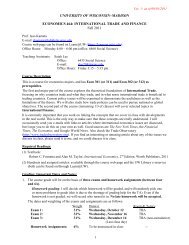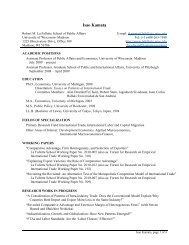SAVE Commission's findings - La Follette School of Public Affairs ...
SAVE Commission's findings - La Follette School of Public Affairs ...
SAVE Commission's findings - La Follette School of Public Affairs ...
You also want an ePaper? Increase the reach of your titles
YUMPU automatically turns print PDFs into web optimized ePapers that Google loves.
GOAL #20: AN ENTIRELY NEW SYSTEM<br />
20.1<br />
20.2<br />
20.3<br />
20.4<br />
Establish pilot projects and a goal <strong>of</strong> a new<br />
management system by July 1, 1997. For results-oriented<br />
government that allows employees<br />
to function efficiently and effectively, reform<br />
the budget, civil service organizational<br />
management system and procurement process.<br />
Steps to be taken include:<br />
a. Create a cabinet-level government redesign<br />
position to provide visible leadership in<br />
implementing all aspects <strong>of</strong> government<br />
reform, especially improving the personnel<br />
system.<br />
b. Immediately commence at least two pilot<br />
reform projects that demonstrate the ability<br />
<strong>of</strong> labor and management to achieve<br />
results in a mission-driven organization by<br />
identifying and removing barriers to performance.<br />
The Governor and Legislature<br />
must provide direction, freedom and oversight.<br />
Insights learned from the pilots will<br />
be continuously plugged into the reform<br />
process.<br />
c. Commence implementation <strong>of</strong> the new<br />
management system by July 1, 1997.<br />
Adopt a strategy-driven budget process. To<br />
achieve budgets that demand results and see<br />
government as one system, state law should<br />
require strategically developed budgets that<br />
involve many government interests focused on<br />
major objectives. To be effective, strategies<br />
must involve state, local and education government,<br />
with legislative and executive involvement.<br />
The first new budget should be in<br />
1997-99.<br />
Budget for results, not by agency. To facilitate<br />
outcome budgeting, biennial budgets should<br />
be based on results in core areas such as safety,<br />
health, learning and tourism, not by agency.<br />
Agencies will focus on results, rather than protecting<br />
turf. Agencies failing to budget for results<br />
should risk losing the assigned responsibilities<br />
and associated budget dollars and staff.<br />
Reform infrastructure budgeting, decisionmaking<br />
and use. To make infrastructure budgeting<br />
meet reality, end government units’ exclusive<br />
use <strong>of</strong> buildings and other infrastructure.<br />
Reform the infrastructure decisions to<br />
force interagency, state-local and technical and<br />
political interests to see one system (see Goal<br />
#8).<br />
20.5<br />
20.6<br />
20.7<br />
20.8<br />
20.9<br />
20.10<br />
20.11<br />
Reward employees and agencies for saving<br />
money. To encourage frugality, employees and<br />
their work units should be allowed to keep a<br />
portion <strong>of</strong> allotted funds they save. Some<br />
money should be given to employees and<br />
employee teams under certain conditions.<br />
Units should be able to spend some <strong>of</strong> the savings<br />
on priority tasks for at least one time.<br />
Evaluate more reliable long term revenue<br />
sources. To bring tax policy more in line with<br />
21st Century economics, examine existing tax<br />
sources in light <strong>of</strong> other, emerging alternatives<br />
that, because <strong>of</strong> economic, technological or<br />
other changes, are better able to meet state and<br />
local goals.<br />
Establish one electronic government transaction<br />
service. To reduce paperwork, all state,<br />
local and educational governments should be<br />
on one electronic, financial transaction system.<br />
The system should be used for other information<br />
needs such as grant applications, management<br />
guidance, best practice sharing, etc.<br />
Eliminate Constitutional restrictions on purchasing.<br />
To eliminate unnecessary paperwork<br />
and give added purchasing flexibility, abolish<br />
outdated Constitutional restrictions on state<br />
printing procurement.<br />
Modernize procurement practices, top to bottom.<br />
To get greater value, eliminate overly detailed<br />
state procurement laws, giving flexibility<br />
to employees to buy for best value. Maintain<br />
credibility through oversight based on results<br />
and regular disclosure <strong>of</strong> costs, not details,<br />
and through commitment to minority<br />
participation.<br />
Purchasing agents should become helpers and<br />
compete. To help units be better buyers, procurement<br />
personnel should focus on training,<br />
planning, coordination and partnering. Their<br />
service becomes largely self-funded but state<br />
agency “customers” could buy procurement<br />
services elsewhere.<br />
Use strategic partnerships like businesses. To<br />
give government the same quality and value<br />
as business customers, ease restrictions on strategic<br />
partnerships, joint ventures and contracts.<br />
Partnerships <strong>of</strong>ten produce long term savings<br />
that are difficult to achieve through current<br />
government bidding.<br />
CITIZEN • COMMUNITY • GOVERNMENT — WISCONSIN: THE 21 ST CENTURY 69



